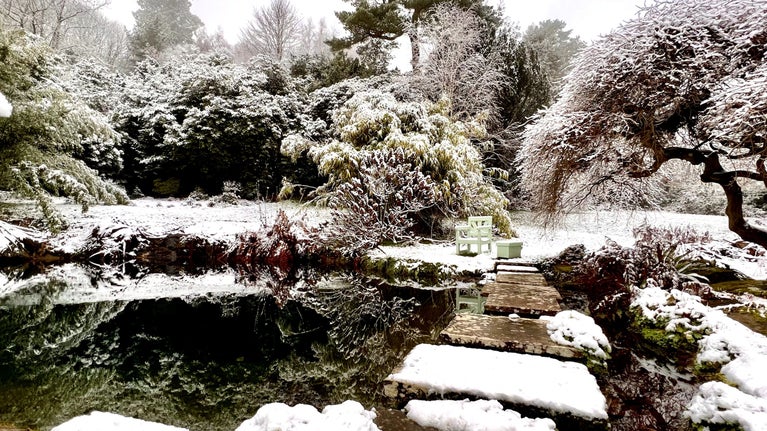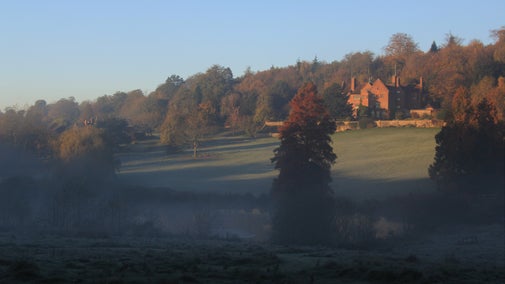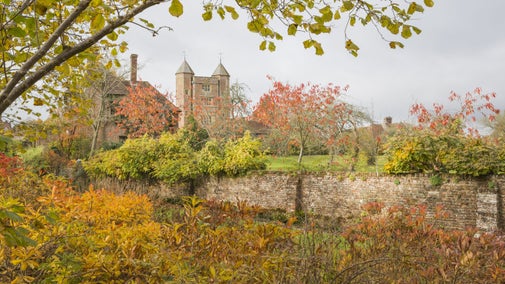
Discover more at Chartwell
Find out when Chartwell is open, how to get here, the things to see and do and more.

Born from the keen amateur, creative gardening minds of Sir Winston and Lady Churchill, the garden at Chartwell is as varied as it is beautiful all year round. History and nature merge seamlessly across the estate, from Clementine's Rose Garden to the walls of the Kitchen Garden that Sir Winston helped to build.
As we head into the dormancy of winter, now is the time to appreciate the structural elements of the garden. At Chartwell, this consists of the terraces, the walls, the tightly clipped yew (Taxus baccata) hedges and clean edges of our borders. These are the unsung heroes of a garden that often get forgotten in amongst the luscious growth and colour of the herbaceous plants during spring and summer. These structural elements are the backbone of the garden that give it its unique character.
Across the garden, there are a number of plants to keep an eye out for as we head through winter and longingly towards spring. The aptly named ‘Christmas box’ (Sarcococca confusa) produces small, delicate, white flowers that can be smelled long before they’re seen. As lovers of shade and moderately dry conditions, this plant thrives in the borders near Chartwell’s most significant tree, the Japanese cedar (Cryptomeria japonica). Another reliable performer throughout winter is the winter jasmine (Jasminum nudiflorum). This tough climber is a great way of adding a warming splash of yellow to the garden at a time when floral offerings can be few and far between.
The colour of our trees should not be forgotten. The paperbark maple (Acer grisium) at the top of the Kitchen Garden steps provides a warming splash of colour, especially towards the end of the day as the sun sets across the Weald of Kent. As its common name suggests, the delicate, peeling bark has an almost cinnamon hue that shows that it's not just flowers that can bring colour to a garden. But if it’s flowers that you like, keep an eye out for Daphne bholua ‘Jacqueline Postill’ with its intoxicating scent, and many varieties of camellia such as Camellia 'Cornish Snow' (C. cuspidata × C. saluenensis) offering floral abundance throughout.
Hellebores are the first of our herbaceous plants that come into flower at the beginning of each year and can be found dotted around the garden. Commonly known as the ‘Christmas Rose’, the best display of these semi-evergreen perennials is throughout the borders flanking the path that leads from the visitor centre into the garden. Helleborus × hybridus ‘Pink Lady’ offers us bursts of delicate pink throughout these borders.
As you enter Chartwell, heading up from the northern end of the estate along the paved pathways, the views soon open up to the wide lawns and lakes.
The first feature you’ll see is the swimming pool, once a favourite of the Churchill family and now a favourite of the resident black swans and visiting geese. One of the most captivating areas here is the Gavin Jones Cascade which trickles steadily down into the swimming pool. Please be aware that is not suitable for swimming as it is now managed for the wildlife.
When Winston Churchill first saw Chartwell in July 1921, he was captivated by the views and the beautiful valley cascading down to the lake. Inspired, the Churchills purchased the estate the following year and immediately began enhancing its natural features.
To preserve the historic 1930s headwall, we are undertaking essential conservation works. A temporary dam has been installed to allow us to inspect the area over several seasons whilst continuing to protect the lake’s importance as a wildlife habitat. We appreciate your patience and understanding whilst the path remains closed.
The Gavin Jones Cascade and surrounding garden is made up of several different areas, each with its own unique character and fascinating history. Originally displayed as part of the 1948 Chelsea Flower Show where Clementine Churchill first saw it, she liked it so much that the designer Gavin Jones gave it to her as a gift.
Just before you reach Lady Churchill’s Rose Garden, you’ll come to a series of ponds. There are three interlinked ponds here that form the upper part of the Gavin Jones Cascade. The lower of the three ponds is called the Golden Orfe Pond and is filled with descendants of the exotic fish that Churchill bought from Harrods after seeing them in the 1930s.
Sitting behind the wall near the Golden Orfe Pond, you’ll find the Rose Garden, designed by Clementine herself. The Garden Team have planted this area with Hybrid Tea roses of the style that was used by Lady Churchill. Varieties to look out for include Rosa ‘Ice Cream’, Rosa ‘Lovely Lady’ and Rosa ‘Savoy Hotel’.
The centrepiece of the garden is formed by four standard wisteria trees that bloom purple in the spring. Although these are the common Wisteria sinensis variety, what makes them special is they’ve been planted upright as a ‘standard’ rather than more recognisable and traditional wall-trained displays.
Enjoy this sun trap surrounded by intense colours and fragrances in what is perhaps the most quintessentially English feature of the garden at Chartwell.
With panoramic vistas over the Chartwell estate and Weald of Kent, the terrace is the perfect place to enjoy the view, no matter the season.
At the north end of the terrace lawn, is the distinctive Marlborough Pavilion, named for the man who inspired its decoration and Churchill’s ancestor, John Churchill, the first Duke of Marlborough.

A wide variety of apple trees grow in the orchard, many of which are the same varieties that the Churchills would have also grown whilst living here at Chartwell. There's a selection of culinary, dessert, and crab apples including 'Bramley's Seedling', 'Kerry Pippin', 'John Downie', 'Newton Wonder', and 'Lord Derby'. We also planted a 'Winston' apple tree in the main orchard, and we can’t wait for it to really get growing!
The orchards were important to Churchill, and they’re important to us, too. For most of the year, we manage the grass throughout the orchard just as the Churchills did, as a meadow. This allows a variety of wildflower species to flourish. This in turn ensures that we offer a consistently rich habitat for local wildlife. After the September harvest, you can buy delicious Chartwell apple juice in the shop.
From fruit and vegetables, beautiful cut-flower beds to the Golden Rose Avenue – and not forgetting the chickens – the Walled Garden has a bit of everything. The present Walled Garden dates from the mid-1920s when the surrounding brick wall was built. A plaque states, 'The greater part of this wall was built between the years 1925 & 1932 by Sir Winston Churchill with his own hands.'
Whilst you're exploring the Walled Garden, pop into the Marycot, a little brick house that Sir Winston Churchill built himself for his daughter Mary.
A walk to the farthest reaches of the garden is well worth it for the Golden Rose Avenue that awaits you. The avenue was a gift to Winston and Clementine from their children and grandchildren on the occasion of their 50th Wedding Anniversary in 1958. This area was recently restored with more than 200 golden roses, all underplanted with catmint (Nepeta × faassenii) and lambs-ears (Stachys byzantine). Garden birds make the beech hedges their home. Soon it will once again be full of colour, sounds and fragrance. See if you can spot the inscription on the plinth reading 'Here lies the Bali Dove', Clementine’s beloved pet dove that she brought to Chartwell from Bali in 1936.

Black swans, originally native to Australia, were first kept at Chartwell in the 1920s after they were gifted to Sir Winston. Please help us take care of the swans by giving them some distance and not feeding them. Wildfowl are sensitive and may peck if they feel uncomfortable.
In the Walled Garden is ‘Chickenham Palace’, home to a variety of bantam chickens, each with their unique colouring and feathering. Which one will be your favourite?
Sir Winston had a true passion for nature and spent time attempting to reintroduce lost butterflies. The Garden Team share this passion for butterflies and have an entire border dedicated to plants that are perfect for these winged insects. This border can be found sandwiched between the croquet lawn, the orchard, and the Butterfly House.
Keeping Churchill’s beekeeping tradition alive, there are six beehives in the private orchard tended to by trained volunteers. There are also some feral bee colonies living out in the woodland. Surplus honey is harvested by volunteers at the end of August and has won several awards from the British Beekeepers Association.
To discover the stories behind the garden at Chartwell and explore at your own pace, pick up a free audio guide from the visitor centre on arrival.

Find out when Chartwell is open, how to get here, the things to see and do and more.
Discover the beloved home of one of Britain's greatest politicians, Sir Winston Churchill. The house has many treasures and provides an intimate portrait of the Churchill family.

From tasty treats and hot and cold dishes, to souvenirs, gifts and Churchill memorabilia, you'll be spoiled for choice in the Chartwell café and shop. Why not treat yourself?

Chartwell’s estate and surrounding countryside offers far-reaching views across the Weald. Walk in the footsteps of one of our founders Octavia Hill when you explore Mariners Hill.

Chartwell is a three pawprint rated place. Bring your four-legged friend along on a short lead for a stroll around the garden or go for a roam in the woods. Find out more about where you can and can't take your dog.

Roses have long been associated with the Churchills and their family home, Chartwell in Kent. The flower was a part of Winston and Clementine's love story from the very beginning.

The Trust’s story at Chartwell began whilst Winston Churchill and his family were still in residence. Discover how we helped to preserve a significant piece of British history.

Find out about the behind-the-scenes work that goes into conserving parts of the garden at Chartwell, including a wildflower meadow, opening up views and flower border replanting

Wander through the National Trust’s autumn gardens in Kent, where golden foliage and late-season blooms create a tapestry of rich colour and texture. Admire the russet tones and crisp air at Sissinghurst Castle, stroll through the mellow hues of Chartwell’s borders, and enjoy the romantic reflections of autumn leaves in the moat at Scotney Castle. From fiery rudbeckia and amber lilies to Japanese anemones and ornamental grasses swaying in the breeze, Kent’s historic gardens offer a serene and striking celebration of the season.
